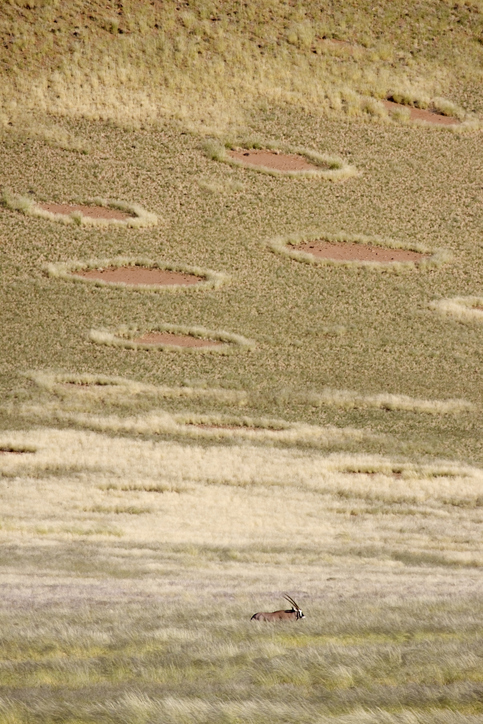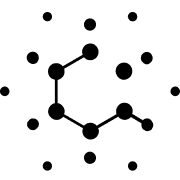
It is clearly difficult to dig up the patterns in biology. Not so for rock.
It is not so obvious that those patterns matter much though. They certainly predict a reaction event. That event may be benign or necesaary to optimize local success.
Think of the patterning produced by slime molds. what is that all about. yet there is amazing order there often of no consequence or not any we can see. After all a slime mold flower is not going to pollinate or assist reproduction at all.
Does the slime mold create odd shapes for pleasure?
A Mathematician Who Decodes the Patterns Stamped Out by Life
Corina Tarnita deciphers bizarre patterns in the soil created by competing life-forms. She’s found that they can reveal whether an ecosystem is thriving or on the verge of collapse.
Corina Tarnita decoded mysterious “fairy circle” patterns in the landscape. Photo by Sasha Maslov for Quanta Magazine.
https://getpocket.com/explore/item/a-mathematician-who-decodes-the-patterns-stamped-out-by-life
When Corina Tarnita was a budding mathematician, she found her interest in mathematics flickering, about to burn out. As a girl she had stormed through Romania’s National Mathematical Olympiad — where she won a three-peat from 1999 to 2001 — then on to Harvard University as an undergraduate and straight into its graduate school to study questions in pure mathematics.
Then suddenly, around a decade ago, it wasn’t so fun anymore. “I would still get a kick out of solving a problem,” she said. “The question is whether it was just kind of an ego kick.”
Facing a crisis of faith, Tarnita felt her future narrow to just a few paths. She had been offered a cushy “quant” job working for a bank. She could take time off. And then she found in the library an intriguing book with a colorful cover called Evolutionary Dynamics: Exploring the Equations of Life. The book’s author, the mathematical biologist Martin Nowak, was, conveniently, also at Harvard. The same week she had to decide on the job, she sent him an email asking to meet.
The meeting changed her life. Tarnita turned down the job and finished her doctorate with Nowak. (She completed her Ph.D. just a year after earning her master’s degree.) She began a project with him and the legendary biologist Edward O. Wilson that led to a 2010 Nature paper on the evolution of cooperative insects like ants and termites. Since 2013, she has continued to study biology using mathematical tools as a member of the faculty at Princeton University.
Since switching fields, Tarnita has focused her work on how living things orchestrate themselves itself into patterns on different scales. Sometimes the forces of natural selection bear down on individuals. Other times, they act on a unit such as an ant colony. Other collective organisms such as slime molds must contend with evolutionary pressures both on the whole and on individuals. And in still larger systems like the African savanna, evolution shapes the component parts, but not the whole. “From the small scale to the large scale,” she wonders, “does nature use the same rules?”

Fairy circles are bare patches that dot the Namibian landscape. Photo by milehightraveler / Getty Images.
Of all the patterns Tarnita explores, one of the most enchantingly enigmatic are fairy circles: barren round patches that dot the grasslands of Namibia like pepperoni slices on a pizza. They can persist as long as 75 years, but their cause has been hotly debated. Some scientists argue that termite colonies build and maintain the bare circles, while others blame them on plants battling for water across the arid landscape. In January 2017, Tarnita and her colleagues published an article in Nature that suggested a compromise: that both processes together, acting on different scales, could imprint the observed pattern on the ecosystem.
Among her other projects, Tarnita is still working on understanding the fairy circles, which may someday allow environmental scientists to tell from satellite imagery if an ecosystem is on the verge of collapsing into a desert (or if it’s especially resilient). Quanta caught up with her to ask about her early forays into mathematics, her career arc and her current research. The interview has been condensed and edited for clarity.
You recently argued that we need to better understand how systems like multicellular organisms evolve out of individual units. What would this kind of research program look like?
If you think about any kind of system, hierarchical organization is everywhere. Similar units are somehow combined to create a new level. Whether it’s human society, ant society, zebras, primates or multicellular organisms formed of single cells, these combinations happen a lot in nature. I’m trying to understand how nature organizes simple, similar individuals into a new level that might do different things.
For example, maybe you’re a single-celled organism. You’re eaten by a predator, and that predator has a mouth as big as you but not bigger. You can’t grow too big as a single cell, so your only option is to be together with other cells. You could do that in a couple of different ways. If you find one way of doing it, does that preclude you from finding another way? If you find a simple solution to something, that might not be the best solution. Evolution is not necessarily an optimizer. It’s a tinkerer. How much of it is due to just accidents?

Tarnita in her office at Princeton University. Photo by Sasha Maslov for Quanta Magazine.
You started out as something of a prodigy. How did you get your start in math?
My mom is a professor of materials science and an engineer and is very fond of math. She always approached it as: Math is a language. Just like with any other language, the earlier you start, the better you can get at it. She started me really early. Everything we talked about — much to my frustration as a child — had some sort of math in it. But I think that really served me well.
When did you start winning Mathematical Olympiads?
In sixth grade I won, and I was very pleased. What I remember is I felt very calm about it, about doing math in general. Sixth grade made me realize this is fun, this is great; I’m going to keep doing this. Ninth grade was the time when I really had a moment of reckoning. Was I doing it because my mom had been encouraging it for so long, or is this something that really was just me? Is math going to be it? The answer was yes. The win that year meant the most.
In graduate school, you went through another moment of reckoning and then ended up working with one of the world’s most famous biologists, E.O. Wilson. What was that experience like?
I always felt blissfully unaware of the giants of a lot of the fields that I wasn’t part of. I didn’t grow up revering E.O. Wilson. It wasn’t like meeting Andrew Wiles, or any of these giants of mathematics. When I came to Princeton, I ran into John Nash, and I felt pretty much overwhelmed. It was hard for me to actually say anything to him, which was so strange. But with Ed it was like oh, he sounds amazing, I’d love to meet him, and let’s see where this goes.
But then I ended up getting a lot more from it than I would have expected originally. I had never worked with someone who was a real biologist, who had spent time in the field, who had a favorite organism.
For hours he could talk about ants, and just tell the most amazing stories. He made me realize I am a biologist.
Since going to Princeton, you seem to have followed Wilson’s lead and found a social insect to keep coming back to. How did you get into termites?
I was looking at evolutionary questions, like the evolution of social behavior and of cooperation. I moved to Princeton, and I realized you need to understand ecology to understand behavior. That’s how I started to get interested in the termites, and their way of spatially organizing themselves.
Termites break down dead matter. They release all these nutrients into the system, and they do so on their mounds, so vegetation grows much better. There are more lizards there, there are more spiders, there are more grasshoppers.
One of my closest collaborators, Rob Pringle, had shown that in a system where we work in Kenya, termite mounds are evenly spaced. The fact that termite mounds are equally distributed like that throughout the savanna enhanced the productivity of the system more than any other random distribution of those mounds.
This could be interesting: How could a tiny termite create this amazing spatial patterning that could go for hundreds and sometimes thousands of kilometers, that can be seen from space? What drives that? The system doesn’t evolve. It’s not like a multicellular organism.
So how do they do it?
They space each other out because of really strong competition for resources. If two different colonies run into each other, they will fight to the death. They like to be separated from each other, and so they create this hexagonal, honeycomb-type pattern.

Photo by Sasha Maslov for Quanta Magazine.
With Pringle in Science in 2015, and again with him in the Annual Review of Entomology this year, you argue that it’s crucial to separate this kind of pattern of green islands caused by termite mounds — which signify a healthy ecosystem — from similar-looking patterns that would mean an ecosystem is failing. Can you walk me through this second kind of pattern?
Do you know about Alan Turing? Turing was obsessed with morphological patterns. Why do tigers have stripes, why do leopards have spots, and so on. He created what’s called an activator-inhibitor system, and it’s a very elegant system that people had employed for vegetation as well.
The Turing-type pattern says that when I have a lot of rainfall, the world should look like my well-watered lawn. As I start to lose precipitation I start to lose biomass, but the way I lose biomass is in a very predictable manner. The first thing I should see is something that looks like regular gaps of vegetation. As you keep decreasing the precipitation, those gaps start to form this maze-like pattern that looks like a beautiful labyrinth. As you keep decreasing the precipitation even further, those gaps stretch even more into spots.
And immediately after you’ve gotten to the spots-like stage, if you keep losing precipitation, the very next thing you should see is desert. You have what’s called catastrophic collapse. You just immediately lose everything.
I wondered: If I compared this pattern with the healthy patterns formed by termite mounds, would they look the same to me? We can’t just look at photos of patterns and say which shape is going to be bad or not.
Both termites and vegetation can create green spots in places like your site in Kenya. These same two factors are viewed as the big competing theories for Namibia’s mysterious fairy circles. But it seems like the fairy circles are almost the opposite: just bare patches in grassland. How can you move from one system to the other?
Termites create a lot of different mound types. We thought you don’t always expect them to look like islands of vegetation. Sometimes you expect them to look like castles, and therefore from photos they will probably look like bare patches.
What our framework has said is that when you have termites and vegetation in the same system, they both might be organizing. Both are processes that should in principle occur simultaneously. So what we asked is: What if these two processes actually happen on two very different scales? That would be great.
On one scale you should get a very large pattern that’s dominated by termites. But then if we really zoomed in and started to look in between the circles, we should see a smaller-scale pattern predicted by the Turing models. We sent students to Namibia, and they took photos of the vegetation, and they loved it. (They will be very happy if we do the most exotic projects in the most exotic places.) We found two patterns: Termites basically drive the big pattern of the fairy circles, but vegetation is also self-organizing, and it couldn’t be creating the large circles because it’s creating smaller spots. We want to now start setting up experiments there to really clinch this.
Once you understand what causes the different spotty patterns more generally, is the idea to diagnose from above how ecosystems are faring in the face of climate change?
We’re not kidding ourselves into thinking that this will be the answer to everything. We’d like to understand this because we would love to be able to use this in some way for conservation reasons. Then there’s the broader sense that this is just remarkable.
What we want are some predictive tools. Patterns, for us, are a little bit of a hopeful inroad into a complicated system. Who would expect that an African savanna, with all of its complexities, might show such amazingly regular patterns? Just to find such amazing symmetry in something that is so messy and has so many dimensions and elements is already an incredible surprise. We’re hoping that symmetry might teach us something about how things work in that system. Not everything, but some things.
Joshua Sokol is a freelance science journalist in Boston.

No comments:
Post a Comment